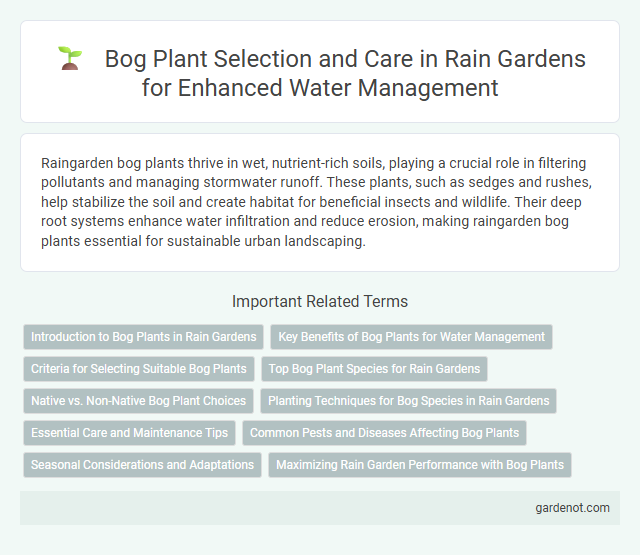Raingarden bog plants thrive in wet, nutrient-rich soils, playing a crucial role in filtering pollutants and managing stormwater runoff. These plants, such as sedges and rushes, help stabilize the soil and create habitat for beneficial insects and wildlife. Their deep root systems enhance water infiltration and reduce erosion, making raingarden bog plants essential for sustainable urban landscaping.
Introduction to Bog Plants in Rain Gardens
Bog plants in rain gardens play a crucial role in enhancing water absorption and supporting wetland ecosystems by thriving in nutrient-poor, acidic, and consistently moist soils. Species such as Sphagnum moss, sedges, and carnivorous plants like pitcher plants adapt to saturated conditions, helping filter pollutants and improve water quality. These plants contribute to stormwater management by stabilizing soil and providing habitat for local wildlife within rain garden installations.
Key Benefits of Bog Plants for Water Management
Bog plants in rain gardens play a crucial role in water management by enhancing water retention and filtration, reducing runoff, and improving groundwater recharge. Their deep root systems stabilize soil, prevent erosion, and promote the breakdown of pollutants, supporting cleaner water cycles. These plants also create habitats for wildlife, contributing to biodiversity while maintaining the ecological balance in wetland environments.
Criteria for Selecting Suitable Bog Plants
Suitable bog plants for rain gardens must tolerate saturated soil conditions and periodic flooding while thriving in acidic, nutrient-poor environments. Selecting native species such as Sphagnum moss, sundews (Drosera spp.), and bog rosemary (Andromeda polifolia) ensures ecological compatibility and supports local biodiversity. Planting criteria prioritize water absorption capacity, root structure stability, and resistance to fluctuating moisture levels to maximize rain garden efficiency.
Top Bog Plant Species for Rain Gardens
Top bog plant species for rain gardens include Sphagnum moss, which enhances water retention and acidity; Bog Rosemary (Andromeda polifolia), known for its fragrant flowers and tolerance to wet, acidic soils; and Labrador Tea (Rhododendron groenlandicum), valued for its evergreen foliage and pollution resistance. These species thrive in saturated, nutrient-poor conditions typical of rain gardens designed to manage stormwater runoff. Incorporating these bog plants improves biodiversity and supports natural filtration in rain garden ecosystems.
Native vs. Non-Native Bog Plant Choices
Selecting native bog plants for a rain garden enhances local biodiversity by supporting pollinators and adapting well to regional climate conditions, reducing maintenance requirements. Non-native bog plants may offer unique aesthetics but risk becoming invasive and disrupting ecosystem balance. Prioritizing native species like sedges, rushes, and wildflowers promotes sustainable water filtration and habitat resilience in rain garden environments.
Planting Techniques for Bog Species in Rain Gardens
Planting bog species in rain gardens requires selecting moisture-tolerant plants such as sedges, rushes, and native wildflowers that thrive in consistently wet conditions. To establish these plants effectively, prepare the soil with organic matter to enhance moisture retention and ensure shallow planting depths to prevent root rot. Proper spacing allows air circulation and growth, while mulching helps maintain soil moisture and reduces weed competition.
Essential Care and Maintenance Tips
Raingarden bog plants require consistent moisture and partial to full sunlight for optimal growth, thriving in wet, boggy soil conditions that mimic their natural habitat. Regularly remove debris and dead foliage to prevent disease and promote healthy airflow, while monitoring soil drainage to avoid water stagnation that can harm root systems. Seasonal pruning and mulching help maintain plant vigor and soil moisture, ensuring the raingarden remains an effective natural water filtration system.
Common Pests and Diseases Affecting Bog Plants
Common pests affecting raingarden bog plants include aphids, spider mites, and snails, which can cause significant damage by feeding on leaves and stems. Diseases such as root rot and powdery mildew are prevalent in bog environments due to excess moisture, leading to poor plant health and decay. Effective management involves monitoring for symptoms, promoting good air circulation, and maintaining proper water drainage to prevent infestations and infections.
Seasonal Considerations and Adaptations
Raingarden bog plants thrive in consistently moist, acidic soil environments, making seasonal water retention a critical factor for their growth and survival. These plants typically enter dormancy during cold winters, reducing water uptake and metabolic activity to conserve energy. Adaptations such as deep root systems and waxy leaf surfaces help raingarden bog plants manage fluctuating water levels and temperature variations throughout the year.
Maximizing Rain Garden Performance with Bog Plants
Bog plants such as Sphagnum moss, pitcher plants, and cotton grass thrive in saturated, acidic conditions, making them ideal for raingardens designed to manage stormwater runoff. These plants enhance water retention and filtration, improving the garden's ability to reduce pollutants and prevent soil erosion. Incorporating diverse bog plant species maximizes the raingarden's ecological function and aesthetic appeal while supporting local wildlife habitats.
Raingarden bog plant Infographic

 gardenot.com
gardenot.com